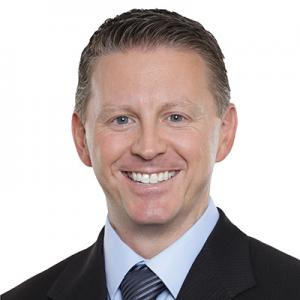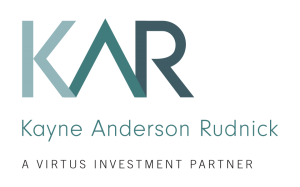
Chris Armbruster, CFA
Portfolio Manager and Senior Research Analyst
Kayne Anderson Rudnick
KAR portfolio manager Chris Armbruster discusses the fourth quarter performance of mid-cap growth equities, the largest stock contributors and detractors in the KAR Mid-Cap Growth strategy, and portfolio positioning for 2024.
Listen Now
Transcript
BEN FALCONE: Hello, this is Ben Falcone, managing director with Kayne Anderson Rudnick, and with me today, I have Chris Armbruster, portfolio manager of the KAR Mid-Cap Sustainable Growth strategy. Chris, equities had strong returns for the fourth quarter, characterized by a broadening out of market returns that had previously been confined to a set of mega-cap stocks for the prior nine months of the year. Can you provide our listeners with your perspective on fourth quarter performance for mid-cap growth equities and how your portfolio performed during the quarter as well as the year?
CHRIS ARMBRUSTER: At the risk of sounding like an excerpt from “How the Grinch Stole Christmas,” the typical Santa Claus rally came anyway in the fourth quarter of 2023 with most major market indices rallying double-digit percentages despite high nominal rates, an inverted yield curve, ongoing and perhaps accelerating global conflict, and rising concerns of consumer softness in 2024.
It's clear investors are looking for things to improve next year. Comments from the Federal Reserve had strong dovish undertones, and the market is now pricing in three 25 basis point rate cuts over the next year. We certainly had strong returns from many high growth, high multiple names in the portfolio, but it was more than offset by major disappointments from a few key names. We would expect the broadening of the market away from the Magnificent Seven would stand to benefit this particular portfolio as many of these names start to reaccelerate growth in a way that maintains recently expanded profitability.
Growth scarcity was one of the factors that caused the market to concentrate around a more limited number of names in 2023. Reflecting back on the year as a whole, the portfolio performed about in line with the benchmark when removing the effect of Signature Bank. The seizure of the company in the wake of the collapse of Silicon Valley Bank and the subsequent decline in that one stock price accounted for a significant portion of the annual underperformance. We would expect outcomes like this for any of our holdings to be very rare going forward.
BEN FALCONE: Chris, can you discuss a few of the portfolio holdings that were key contributors and detractors to performance within the quarter and for all of 2023?
CHRIS ARMBRUSTER: The top five contributors to the Mid-Cap Growth portfolio this quarter are FICO score creator Fair Isaac, IT consulting firm Gartner, Latin and South American e-commerce and fintech innovator Mercado Libre, credit bureau Equifax, and animal health diagnostic leader IDEXX Laboratories.
The name we would like to spend a little more time with this quarter is IDEXX Laboratories. IDEXX is a dominant provider of diagnostic instruments for the veterinary industry. While its overall share of the market is greater than 60%, in some subsegments like chemistry analyzers, its share exceeds 80%. The installed base of equipment is very sticky with retention rates in the high 90% range and high margin recurring consumable revenue making up about 75% of its total.
Pre-pandemic, annual pet adoption growth ran about 1% per year. During the pandemic, that jumped to 5 to 6% per year and then moderated to a still comparatively healthy 2% in 2022. While the underlying demand for pet ownership remains robust, the moderation did have a temporary impact on IDEXX’s growth rate, which was exacerbated by issues attracting and retaining skilled labor in the veterinary field. Additionally, the bolus of younger pets required less veterinary visits and diagnostics. In 2023, macro pressures began to weigh on a number of wellness visits despite the fact that pet owners have routinely shown that they only decrease spending on pets in the most dire of circumstances.
Recently, the company has reaccelerated growth on the heels of stronger pricing power, innovation, and international expansion. Notably, outside the United States, revenue amounts to just 35% of the current total. But OUS markets represent about two thirds of the remaining addressable market over time. We believe increasing pet ownership, aging pet population, and high spending elasticity should prove powerful tailwinds for this business.
The bottom five detractors from the Mid-Cap Growth portfolio’s performance for the quarter were cloud-based human capital management software maker Paycom, online bill payment provider BILL.com, functional energy drink maker Celsius, semiconductor company Lattice, and programmatic advertising platform Trade Desk.
The detractor we wanted to focus on this quarter is Lattice Semiconductor. Field programmable gate arrays, or FPGAs, are off-the-shelf chips that can be programmed and reprogrammed to carry out certain functions. They are used in a wide variety of expanding applications, including communications, computing, industrial, and automation. This expansion is driven by the need for smarter edge devices to have compute power. This market has historically been dominated by three players. While the other two players differentiate around logic density and focus more on larger form factor FPGAs for more intense compute applications, Lattice has focused more on small form factor, high power efficiency opportunities. The addressable market is smaller, but we believe that has worked in Lattice’s favor as the two rivals have been more focused on the larger addressable markets to justify their expensive acquisitions.
Other notable evolution in FPGAs beyond the compute need-driven application expansion is the ability to more easily program them. Historically, developers required special training to be able to effectively program an FPGA. Today, however, they can be programmed using more well-known industry frameworks, like TensorFlow and PyTorch, and Lattice has even developed software stacks that further ease the programming burden and can be predesigned to be application specific. So, a customer looking to use FPGAs for its factory automation could get them preloaded with configurable automation software.
We believe most of the recent weakness in the stock can be traced to an abnormal ebb and flow of demand rather than anything structural yet in the underlying business. A majority of Lattice's sales run through a distributor network. Distributors were carrying a slightly elevated level of Lattice inventory due to issues in past quarters obtaining enough supply. Higher interest rates and slowing macro, especially in Europe, led to distributor destocking and a delay in refilling the channel. The company said that lead times were back to normal, and while it may take a few quarters to normalize distributor inventory levels, we view this as a temporary disruption.
BEN FALCONE: Chris, as we head into 2024, thinking about the current backdrop for the economy as well as it being an election year, can you speak about how your portfolio is positioned relative to your benchmark?
CHRIS ARMBRUSTER: Election years, even contentious ones, are not historically something to fear in and of themselves. In fact, the S&P 500® has not declined in a year where an incumbent president was looking to be reelected since 1952. There is a distinct reason for this phenomenon, and that is the incumbent administration does everything it can to stimulate the economy to an extent that voters feel good about things when they go to the polls.
Far more worrisome for us going forward is the ongoing geopolitical conflicts and the downstream ramifications of reduced trade and deglobalization, which is inherently inflationary and could delay the Federal Reserve's ability to normalize interest rates. This headline risk likely creates some heightened volatility in the markets. We don't typically position the portfolio based on macro-related outlooks like this. So, our job this year will be to monitor how it unfolds and see how our businesses weather any challenges that might arise and how our companies respond to the likely turbulence in the year to come.
BEN FALCONE: Chris, thanks for taking the time to provide your insight to our KayneCast listeners.
This information is being provided by Kayne Anderson Rudnick Investment Management, LLC (“KAR”) for illustrative purposes only. Information contained in this material is not intended by KAR to be interpreted as investment advice, a recommendation or solicitation to purchase securities, or a recommendation for a particular course of action and has not been updated since the date of the material, and KAR does not undertake to update the information presented should it change. This information is based on KAR’s opinions at the time of the recording of this material and are subject to change based on market activity. There is no guarantee that any forecasts made will come to pass. KAR makes no warranty as to the accuracy or reliability of the information contained herein.
Past performance is no guarantee of future results.
3366785
